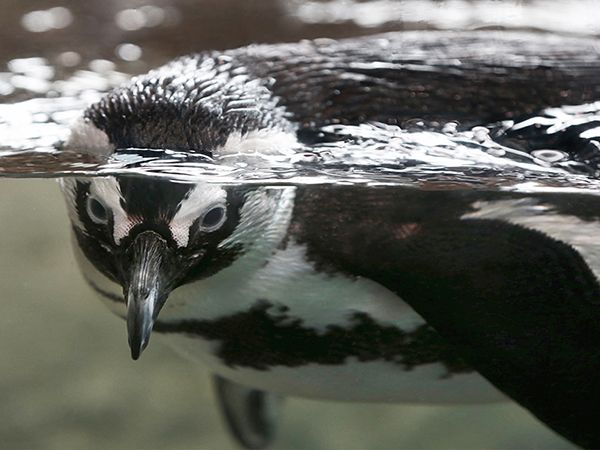Few places bring adults as much unbridled joy as an aquarium. On my recent visit to New Orleans's own Audubon Aquarium of the Americas, it was hard to even count the amount of tall, manly men I witnessed excitedly pointing out sharks and penguins, bouncy children jumping up and squealing over otters, nostalgic parents pulling animal factoids out of their fragmented memories, and studious individuals having a meditative moment in front of the mesmerizing, low-light jellyfish tanks.
A day at the aquarium is an immersive experience. Each exhibit has dozens of animals to get excited about, but if you're like me, you'll get attached to a favorite. Mine clocks in at around 250 pounds.
Meet Midas, the green sea turtle! Surrounded by intimidating sharks that he pays no mind, this guy is the king of the Gulf tank.
Audubon's Director of Husbandry Higinio Covarrubias, who guided me on my tour, corroborates that I am not alone in my admiration of Midas. "Everybody wants to find the sea turtle in here—Midas is the star of the Gulf exhibit. He goes everywhere, gets into everything. During feed time, he tries to steal food from all the other animals. He came to us from the New York Aquarium
He's around 50-years-old by now. The unique thing about Midas is that when sea turtles are young, they eat a lot of protein, but when they're older, they eat a lot of grasses and algae. In this environment, because we feed the sharks big hunks of fish, he likes to steal those. We'll put heads of romaine lettuce in the tank so he can graze, but he prefers to get after the sharks' food every time."
The natural flow of exhibits mirrors the Mississippi River you view from the windows of the building. The footpaths meander along, surprising you with wonders from every angle.
You enter at the Great Maya Reef, a marine region that hugs the coast of Mexico, Belize, Guatemala, and Honduras, that the curators here have conveniently squeezed into a first-floor wing. Smiling manta rays lazily swim above as you walk through a tunnel miraculously cut through their waters.
Up the steps in the Amazon Rainforest exhibit, majestic blue macaws fly above and the air is filled with tropical mist. Here, the environment is what captures your attention, but right ahead, it's all about one-on-one time with some particularly playful personalities.
Say hello to the African penguins! These little guys are famous—they have their own Twitter.

"African Penguins are critically endangered," Higinio explained to me. "They do really well in zoos though. We're an AZA-accredited aquarium, which means we have a focus on maintaining sustainability. We participate in the Species Survival Program, so sometimes we move animals around to different aquariums to increase genetic variability. We're trying to promote good genetics for the lifetime of the species. A little bit about these penguins: they're warmer climate birds. The water in their tank is 57 degrees, the air is 63 degrees, but they can tolerate temperatures in the 90s. We've got 20 penguins and each one has a red or a blue band. The ones without bands are babies. It's about a year or so until they have mature plumage."
The seahorses are also a part of the aquarium's Species Survival Program. They have a large variety of colors and types. It's a nice quiet moment, observing their fluttering fins, tiny snouts, and astounding ability to camouflage.
After the seahorse room, we run into another two very distinct personalities: Clara and Ruby, southern sea otters, ages 11 and 5, weighing in at 50 and 47 pounds, respectively.
"Otters can have about a million hairs per square inch, so they're constantly grooming." Higinio told me, "They have extremely low body fat, and spend the majority of their time in the water, moving around, so they're always eating, always hunting around. They get about six buckets of food a day, their metabolism is so high. Ruby was found abandoned, only a day old, in Monterey Bay. The group that took her in kept trying to re-release her but it wasn't successful. She was too used to humans and kept going up to them for food. She was finally deemed un-releasable, so she came here."
After the otters, The Mississippi River Exhibit brings us back home. As well as fresh water fish like paddlefish, sturgeon, alligator gar, and catfish, this area has a red-tailed hawk, a barn owl, and Chompitulous, a fascinating looking 10-foot long, leucistic alligator. "Chomps," as he's affectionately called, is mostly white with splotches of pigment on his snout and bright blue eyes. He's about 12 years old and sprawled out on his dock, soaking in the sunlight, when we meet.
The final exhibit is the Gulf of Mexico. At about 500,000 gallons of saltwater, it is impressive. This tank is Midas the sea turtle's home, but the other guy in charge here is a sand tiger shark named Smooth.
"He's your classic looking shark," Higinio explained. "Even with his mouth closed, all of his teeth are like 'ARRRRGGGG.' If Smooth is ever feeling anxious, everybody's on guard. Socially, Midas rules the roost, but from an instinctual, behavioral standpoint, it's all about Smooth. Getting these species to live in harmony is a challenge. The nurse sharks are docile and curious. They like to pile up next to the water flow or on the diver platforms and let the water run over their gills."
After the guided tour, I spend a while longer observing the curious creatures in this extraordinary place. There's nothing like a day at the aquarium.

